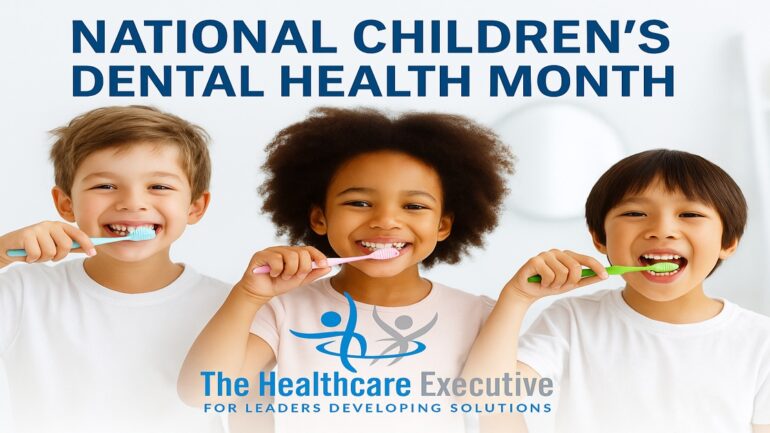National Children’s Dental Health Month 2025

- Posted by Greg Wahlstrom, MBA, HCM
- Posted in Health Observance Calendar
Building Bright Smiles and Healthier Futures
Published: February 01, 2025
Each February, National Children’s Dental Health Month encourages healthcare leaders, parents, and providers to prioritize pediatric oral hygiene. Early dental care is not just about preventing cavities—it’s a cornerstone of long-term health equity. According to the Centers for Disease Control and Prevention (CDC), nearly 20% of children aged 5 to 11 have untreated dental decay. Studies show children with access to preventive care achieve better academic and nutritional outcomes. Systems like Texas Children’s Hospital have integrated dental checkups into pediatric primary care to improve early detection. At The Healthcare Executive, we emphasize oral health integration across care teams. These strategies prove that prevention is more powerful than correction.
Access to pediatric dental care remains uneven across socioeconomic lines, particularly in rural and underserved areas. The Health Resources and Services Administration (HRSA) reports that many dental Health Professional Shortage Areas (HPSAs) lack pediatric-trained providers. To bridge these gaps, hospitals have introduced mobile dental clinics and school-based dental programs. One example is the community outreach initiative at Children’s Hospital of Philadelphia, which delivers fluoride treatments and education directly to local schools. These efforts support early detection while reducing barriers related to transportation and insurance. Many families now rely on virtual consultations, known as tele-dentistry, to receive guidance when in-person visits are not possible. Equitable models must remain a focus for executive leadership going forward.
Technology is transforming how oral health is delivered, tracked, and reinforced. Hospitals are investing in apps that gamify brushing and teach proper hygiene in fun, engaging ways. Providers at Akron Children’s Hospital have integrated oral health risk assessments into electronic health records for early intervention. Pediatricians and dentists are collaborating more frequently through shared care plans and referral dashboards. Oral health is now part of the broader child wellness strategy rather than a siloed specialty. Educational programs endorsed by the American Academy of Pediatric Dentistry (AAPD) stress the importance of the first dental visit by age one. We discuss these strategies in our post on Pediatric Healthcare Strategies for 2025. This connected approach is essential to long-term pediatric success.
Hospital executives must look beyond the clinic to champion systemic change in children’s dental care. At the policy level, organizations such as the American Dental Hygienists’ Association (ADHA) are advocating for Medicaid expansions and school-based reimbursement models. Leadership teams should track oral health metrics on strategic dashboards and support interdisciplinary training that includes oral health in pediatric rotations. Nemours Children’s Health is a leader in integrating oral screenings during primary care visits and providing caregiver education. Strategic investment must also consider workforce recruitment, access to fluoride, and infrastructure upgrades. The Healthcare Executive continues to highlight these priorities across our population health content. Dental health is public health—and February is our moment to lead.
Every child deserves a healthy smile. This February, take time to explore how your organization can advance pediatric dental access and education in your community.
Discover More
For insights into pediatric innovation and health system leadership, read our blog post on Children’s Hospitals: Strategies for 2025.
Internal Links
- Pediatric Healthcare Strategies for 2025 – How health systems are integrating oral care into pediatric population health
External Links
- ADA: National Children’s Dental Health Month
- CDC: Children’s Oral Health
- Texas Children’s Hospital
- HRSA: Oral Health Programs
- Children’s Hospital of Philadelphia: Community Oral Health
- Tele-dentistry Study – NCBI
- Akron Children’s Hospital
- AAPD: American Academy of Pediatric Dentistry
- American Dental Hygienists’ Association (ADHA)
- Nemours Children’s Health
